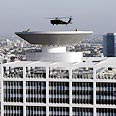
A mock attack successfully implemented on base, security cameras focused on the ground and on trees, monitors who don't use their binoculars, an inadequate fence. Where are all of these things present? In the Rabin Base in Tel Aviv, home to the IDF's top brass.
Rabin Base is located in central Tel Aviv, close to the Azrieli Towers. In addition to housing IDF generals, it also contains the Tel Aviv offices of the prime minister and defense minister.
An investigation to test security of the base revealed serious security issues and determined "the base is not adequately prepared to prevent a terror attack." A summarizing report that reached Ynet indicated that the base was worryingly exposed to threats.
A comprehensive security check back in January 2005 already revealed shortfalls – soldiers unfamiliar with senior positions, inadequate defensive infrastructure and more.
Pursuant to this, the IDF decided to give the base the opportunity to improve its capabilities to address threats and to examine the results at a later time.
Base open to attack
A few weeks ago, a surprise security investigation was once more executed on the base, but nothing had changed.
The investigation was undertaken by a group of trained officers, and tested the overall security of the base, including manpower, efficacy of security teams, defensive infrastructure and patrols on the base.
"In comparison to the findings from January 2005, we can see that the main issues related to effective security of the base and prevention of infiltration into the base, as well as updating the relevant commands, were not taken care of," the report stated.
"The base is extremely exposed to attacks," it went on.
The findings revealed that, although the security mechanism was reexamined and rewritten following the evaluation in 2005, many threats are still not addressed by the existing security mechanism.
This refers, for example, to potential infiltration through the base's main gates during the morning rush hour, as well as a potential attack on the main underground parking lot.
An investigation of the organizational structure of base shows that a second lieutenant - the lowest rank for a commissioned officer - seconds after completing officer's course, can potentially be responsible for some 200 soldiers, many with extreme personal problems.
A long list of problems
Additionally, the investigation indicated that, despite instructions to come up with new operational commands following the previous investigation, no such commands were released.
The source responsible for this said it wasn't done because of a "lack of response to problems that were brought up".
A list of the problems in base security includes a lack of initiated activity for prevention or location of threats, as well as a lack of activities to maintain operational awareness.
Additionally, cameras along the fence are not effective during certain hours, operational indicators did not respond to disruptions along the fence, the operation room's investigation system is not utilized, and the officer responsible for gate security is not aware of problems because information is not passed on properly.
The security investigation team was able to infiltrate members not possessing proper security clearances into the base and proved repeatedly how possible it is to execute a significant terror attack on the base, which, if actually undertaken, would cost the IDF heavy losses.
The investigative team noticed symptoms of widespread apathy regarding the possibility of an attack on the base. It was further noted that some 90 percent of the soldiers responsible for base security have considerable personal problems.
According to team members, such a situation "harms the effectiveness of general security and protection of the soldiers on base."
As for the NIS three million (nearly USD 700,000) allocated in January 2006 for fortification purposes, the report found that none of the projects that the money was intended for have been started.
Resemblance to Almog's kidnapping report
One of the conclusions reached at the end of the investigation bears a disconcerting resemblance to the findings of Maj. Gen. (res) Doron Almog in his investigation of the kidnapping incident which occurred on July 12th of this year.In his report, Almog noted the gap between the existing commands and their implementation in the field, saying that if things had been run differently, the abduction in the north could have been avoided.
Similarly, the inquiry team who compiled the report on Rabin Base wrote in their findings that there exists an analytical breakdown of the threats endangering the base; however there is no available effective response to counter those threats.
The report also covers a series of failings when it comes to matters of defense and emergency procedures for natural disasters. The report found that there was no coordination at all between watchtowers on these issues.
The report ends with a list of recommendations to various IDF bodies. "These recommendations aren't enough," says a senior officer serving in Rabin Base. "The root cause of the problem must be addressed throughout the current system. This includes replacing those who are entrusted with the matter and who fail time and again."
The IDF Spokesperson's office said in response: "An inspection of Rabin Base was indeed carried out. The various failings uncovered during the inspection are being dealt with."
"The IDF is careful to protect all its bases, including Rabin Base. These inspections are regularly carried out and the lessons derived from them are studied and implemented," it continued.















